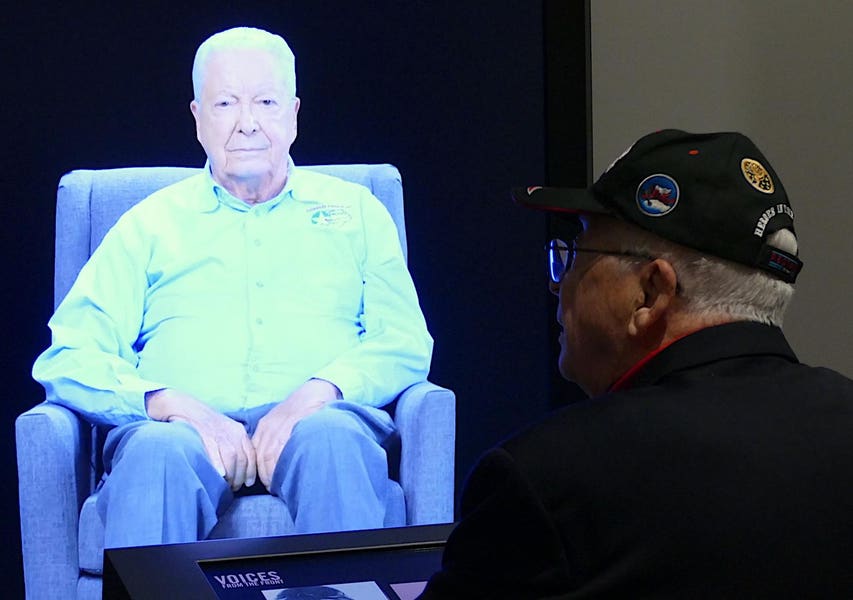
Hershel Woodrow “Woody” Williams was the last living World War II Medal of Honor recipient when he died in 2022. Two years later, a virtual version of the U.S. marine sits tall in a chair at the National World War II Museum, his medal hanging from his neck and military decorations bedecking his hat and blazer. Museum visitors have questions for him about his experiences during the war, and he answers them in his own words and voice.
The Iwo Jima veteran is among the World War II heroes and witnesses featured in a new interactive oral history project called “.” It taps technology, including AI, to let visitors talk with vets, home front workers, Holocaust survivors and other Americans who experienced the war that changed the world in profound and life-changing ways. And it’s another example of how tech can animate historical figures to make their stories more immediate, engaging and memorable. An , for example, recently chatted about his life and art with visitors to the Musée D’Orsay in Paris.
The New Orleans exhibit features conversational videos of 18 Americans, produced in collaboration with the National World War II Museum’s oral history staff. Standing in front of a console, visitors can choose which virtual humans they want to speak with, then ask them anything via a life-size display positioned at eye level to make the interactions feel more authentic and human.
A museum visitor interacts with Ben Lesser, who survived four Nazi concentration camps before being … [+]
Among those sharing stories is Lawson Iichiro Sakai, who served in a segregated Japanese American … [+]
“Preserving the personal accounts of those who served and sacrificed in defense of our freedom during World War II is at the foundation of our mission,” Stephen Watson, the museum’s president and CEO, said in a statement.
Among those telling their stories at the Louisiana museum are Grace (Janota) Brown, a Consolidated Aircraft factory worker who made parts for Boeing B-17 Flying Fortress heavy bombers. Tolley W. Fletcher served in the U.S. Navy during the D-Day landings in Normandy and later hunted German U-boats in the Atlantic and Gulf of Mexico. Ben Lesser, born in Poland, survived four Nazi concentration camps before being liberated from Dachau. Margaret Kerry entertained U.S. troops at USO shows around the country.
In March, on the exhibit’s opening day, Kerry got a chance to talk with her virtual self, as did other subjects featured in “Voices From the Front.”
Margaret Kerry, who who entertained WWII U.S. troops at USO shows around the country, interacts with … [+]
L.A.-based , which makes interactive, conversational videos, powers the experience with its Conversa AI tool, which focuses on contextual understanding to make conversations as natural as possible. In an email interview, StoryFile CEO James Fong clarified that “Voices From the Front” doesn’t use AI to generate answers. Rather, it helps produce interview questions and recognize contexts for them. The company also uses AI for video morphing, such as transitions between poses to make the interviewees’ movements lifelike.
The National World War II Museum was dedicated in 2000 as the National D-Day Museum to tell the story of the American experience in the war. “Voices From the Front” is on display in the museum’s Forbes Gallery of Rare and Iconic Artifacts, formerly called the Forbes Theater. The Forbes family donated funds to the museum, as well as artifacts related to entrepreneur and politician Malcolm S. Forbes’ service as a World War II U.S. Army machine gunner. (Disclosure: Malcom Forbes, son of Forbes magazine founder Bertie Charles Forbes, was also the magazine’s publisher.)
Fong of StoryFile vividly remembers sitting in his grandma’s lap as a child and looking up at her as she recounted air raids and losing loved ones during World War II in China.
“As I grew older, history became more distant and abstract, something to be experienced on TV, in theaters or at a museum,” Fong said. “Voices From the Front,” he added, “strives to bring back that sense of personal wonder, connection and empathy when visitors converse with our heroes from the Greatest Generation.”
George Hardy retired from the U.S. Air Force as a lieutenant colonel and is one of the last living … [+]
